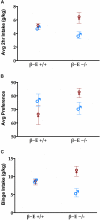Sex and β-Endorphin Influence the Effects of Ethanol on Limbic Gabra2 Expression in a Mouse Binge Drinking Model
- PMID: 30555510
- PMCID: PMC6281685
- DOI: 10.3389/fgene.2018.00567
Sex and β-Endorphin Influence the Effects of Ethanol on Limbic Gabra2 Expression in a Mouse Binge Drinking Model
Abstract
Binge drinking is a widespread problem linked to increased risk for alcohol-related complications, including development of alcohol use disorders. In the last decade, binge drinking has increased significantly, specifically in women. Clinically, sexually dimorphic effects of alcohol are well-characterized, however, the underlying mechanisms for these dimorphisms in the physiological and behavioral effects of alcohol are poorly understood. Among its many effects, alcohol consumption reduces anxiety via the inhibitory neurotransmitter GABA, most likely acting upon receptors containing the α-2 subunit (Gabra2). Previous research from our laboratory indicates that female mice lacking the endogenous opioid peptide β-endorphin (βE) have an overactive stress axis and enhanced anxiety-like phenotype, coupled with increased binge-like alcohol consumption. Because βE works via GABA signaling to reduce anxiety, we sought to determine whether sexually dimorphic binge drinking behavior in βE deficient mice is coupled with differences in CNS Gabra2 expression. To test this hypothesis, we used βE knock-out mice in a "drinking in the dark" model where adult male and female C57BL/6J controls (βE +/+) and βE deficient (βE -/-; B6.129S2-Pomctm1Low/J) mice were provided with one bottle of 20% ethanol (EtOH) and one of water (EtOH drinkers) or two bottles of water (water drinkers) 3 h into the dark cycle for four consecutive days. Following a binge test on day 4, limbic tissue was collected and frozen for subsequent qRT-PCR analysis of Gabra2 mRNA expression. Water-drinking βE +/+ females expressed more Gabra2 in central nucleus of the amygdala and the bed nucleus of the stria terminalis than males, but this sex difference was absent in the βE -/- mice. Genotype alone had no effect on alcohol consumption or drug-induced increase in Gabra2 expression. In contrast, βE expression had bi-directional effects in females: in wildtypes, Gabra2 mRNA was reduced by binge EtOH consumption, while EtOH increased expression in βE -/- females to levels commensurate with drug-naïve βE +/+ females. These results support the contention that βE plays a role in sexually dimorphic binge-like EtOH consumption, perhaps through differential expression of GABAA α2 subunits in limbic structures known to play key roles in the regulation of stress and anxiety.
Keywords: BNST; CeA; GABAA; POMC; alcohol; sex differences; stress.
Figures



Similar articles
-
Effects of Gabra2 Point Mutations on Alcohol Intake: Increased Binge-Like and Blunted Chronic Drinking by Mice.Alcohol Clin Exp Res. 2016 Nov;40(11):2445-2455. doi: 10.1111/acer.13215. Epub 2016 Sep 26. Alcohol Clin Exp Res. 2016. PMID: 27717041 Free PMC article.
-
Sex differences in binge-like EtOH drinking, corticotropin-releasing hormone and corticosterone: effects of β-endorphin.Addict Biol. 2019 May;24(3):447-457. doi: 10.1111/adb.12610. Epub 2018 Feb 8. Addict Biol. 2019. PMID: 29424043 Free PMC article.
-
Sex differences in binge alcohol drinking and the behavioral consequences of protracted abstinence in C57BL/6J mice.bioRxiv [Preprint]. 2023 Sep 30:2023.05.12.540565. doi: 10.1101/2023.05.12.540565. bioRxiv. 2023. Update in: Biol Sex Differ. 2023 Nov 13;14(1):83. doi: 10.1186/s13293-023-00565-0. PMID: 37808817 Free PMC article. Updated. Preprint.
-
CRF modulation of central monoaminergic function: Implications for sex differences in alcohol drinking and anxiety.Alcohol. 2018 Nov;72:33-47. doi: 10.1016/j.alcohol.2018.01.007. Epub 2018 Feb 2. Alcohol. 2018. PMID: 30217435 Free PMC article. Review.
-
The effect of physical therapy on beta-endorphin levels.Eur J Appl Physiol. 2007 Jul;100(4):371-82. doi: 10.1007/s00421-007-0469-9. Epub 2007 May 5. Eur J Appl Physiol. 2007. PMID: 17483960 Review.
Cited by
-
Brief Report: Relationship Between Cotinine Levels and Peripheral Endogenous Concentrations of Oxytocin, β-Endorphin, and Orexin in Individuals With Both Alcohol and Nicotine Use Disorders.Am J Addict. 2021 Jan;30(1):88-91. doi: 10.1111/ajad.13064. Epub 2020 Jun 2. Am J Addict. 2021. PMID: 32488890 Free PMC article.
-
Driving the Downward Spiral: Alcohol-Induced Dysregulation of Extended Amygdala Circuits and Negative Affect.Alcohol Clin Exp Res. 2019 Oct;43(10):2000-2013. doi: 10.1111/acer.14178. Epub 2019 Aug 30. Alcohol Clin Exp Res. 2019. PMID: 31403699 Free PMC article. Review.
-
Sex Differences in the Neurobiology of Alcohol Use Disorder.Alcohol Res. 2020 Oct 8;40(2):04. doi: 10.35946/arcr.v40.2.04. eCollection 2020. Alcohol Res. 2020. PMID: 33042719 Free PMC article. Review.
-
A quantitative trait variant in Gabra2 underlies increased methamphetamine stimulant sensitivity.Genes Brain Behav. 2021 Nov;20(8):e12774. doi: 10.1111/gbb.12774. Epub 2021 Oct 22. Genes Brain Behav. 2021. PMID: 34677900 Free PMC article.
-
Age, β-endorphin, and sex dependent effects of maternal separation on locomotor activity, anxiety-like behavior, and alcohol reward.Front Behav Neurosci. 2023 Apr 5;17:1155647. doi: 10.3389/fnbeh.2023.1155647. eCollection 2023. Front Behav Neurosci. 2023. PMID: 37091593 Free PMC article.
References
-
- Babb J. A., Masini C. V., Day H. E., Campeau S. (2013). Sex differences in activated corticotropin-releasing factor neurons within stress-related neurocircuitry and hypothalamic-pituitary-adrenocortical axis hormones following restraint in rats. Neuroscience 234 40–52. 10.1016/j.neuroscience.2012.12.051 - DOI - PMC - PubMed
-
- Bangasser D. A., Curtis A., Reyes B. A., Bethea T. T., Parastatidis I., Ischiropoulos H., et al. (2010). Sex differences in corticotropin-releasing factor receptor signaling and trafficking: potential role in female vulnerability to stress-related psychopathology. Mol. Psychiatry 15 877–904. 10.1038/mp.2010.66 - DOI - PMC - PubMed
Grants and funding
LinkOut - more resources
Full Text Sources
Miscellaneous

